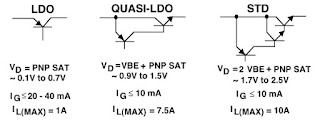THE STANDARD NPN BASED REGULATOR
The first IC voltage
regulators made used the NPN Darlington configuration for the pass device, and
are designated as the Standard regulator.
The voltage
where the output
actually falls out
of regulation (called
the dropout voltage) will probably be somewhere
between 1.5V and
2.2V for a
Standard regulator (it is dependent on both load current and
temperature). The dropout voltage of the
Standard regulator is the highest (worst) of the three types. The ground pin
current of the Standard regulator is the lowest (best) of the three regulator
types.
THE LOW-DROPOUT
(LDO) REGULATOR
The Low-dropout
(LDO) regulator differs from the Standard regulator in that the pass device of
the LDO is made up of only a single PNP transistor
The maximum
specified dropout voltage of an LDO regulator is usually about 0.7V to 0.8V at
full current, with typical values around 0.6V.
The dropout voltage is directly related to load current, which means
that at very low values of load current the dropout voltage may be as little as
50 mV. The LDO regulator has the lowest
(best) dropout voltage specification of the three regulator types.
The ground
pin current in an LDO
regulator is approximately
equal to the
load current divided by
the gain of
the single PNP
transistor. Consequently, the ground pin current of an LDO is the
highest of the three types.
THE QUASI
LOW-DROPOUT REGULATOR
A variation of the
Standard regulator is the quasi-LDO, which uses an NPN and PNP transistor as
the pass device
The dropout voltage
for a quasi-LDO delivering rated current is usually specified at about 1.5V(max).
The actual dropout
voltage is temperature
and load current dependent, but could never be
expected to go lower than about 0.9V (25°C) at even the lightest load. The dropout voltage for the quasi-LDO is
higher than the LDO, but lower than the Standard regulator.
The ground pin
current of the quasi-LDO is fairly low (usually less than 10mA for full rated
current) which is as good as the Standard regulator.
Summary:
Share your comments.
Send your feedback to miycircuits@gmail.com





No comments:
Post a Comment